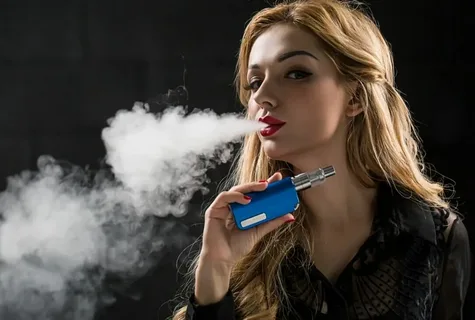Electronic cigarettes didn’t just introduce a new nicotine delivery system; they sparked a subtle but significant evolution in social behavior, community formation, and personal identity. Moving beyond the traditional “smoke break,” vaping cultivated its own distinct culture – “cloud culture” – with unique rituals, aesthetics, and communities, fundamentally altering how users interact with nicotine and each other. Let’s explore this social dimension.
Breaking Away from the Ash Tray: A New Kind of Ritual
The cigarette break was a deeply ingrained social ritual: stepping outside, the shared lighter, the brief camaraderie (or solitude) amidst the smoke. Vaping disrupted this:
Indoor Acceptance (Initially): Early on, vaping’s lack of lingering smoke and smell led to its tentative acceptance in many indoor spaces – homes, bars (before bans), even some offices. This changed the location and frequency of nicotine use. Instead of designated outdoor breaks, vaping could be more integrated, almost continuous.
The Discreet Puff vs. The Cloud Chase: Usage styles diverged. Some embraced discretion – small devices, minimal vapor, mimicking the feel of smoking without the stigma. Others, particularly within enthusiast communities, celebrated the opposite: cloud chasing. Producing massive, dense vapor clouds became a skill, a hobby, and a spectacle, requiring powerful mods, specialized atomizers, and high-VG juice. Competitions (“cloud comps”) emerged, turning vapor production into performance art.
The Demise of the Shared “Light”? While sharing vapes occurs, it’s less inherent than sharing a lighter. Device-specific chargers and personal e-liquid preferences made the ritual less communal in its basic form, though new forms of community arose.
Building “Cloud Culture”: Communities and Identity
Vaping fostered distinct subcultures and new forms of belonging:
Online Hubs: Dedicated forums, Reddit communities (like r/electronic_cigarette, r/Vaping), Facebook groups, and YouTube channels became vital spaces. Users shared intricate coil-building tutorials (“coil porn”), reviewed thousands of devices and flavors, troubleshooted issues, and debated the latest regulations. This digital camaraderie was central to the culture’s growth.
Local Vape Shops as Community Centers: Beyond retail, many shops functioned as social hubs. Lounges allowed users to sample flavors, showcase builds, chat, and simply hang out. Knowledgeable staff (“vape gurus”) were key figures. These spaces fostered a sense of belonging distinct from traditional tobacco shops.
Identity Expression: Vaping devices became personal statements. Choices reflected identity:
The Tech Enthusiast: Sporting complex rebuildable atomizers (RBAs), custom mods, and discussing ohms law.
The Flavor Connoisseur: Curating artisanal e-liquids, chasing the perfect profile.
The Disposable User: Prioritizing convenience, trendy designs, and flavor variety (often younger demographic).
The Quitter: Using simple pod systems focused solely on nicotine replacement.
Aesthetics and Customization: Unlike the uniformity of a cigarette pack, vaping offered immense personalization. From sleek, minimalist pods to elaborately engraved mechanical mods, colorful resin panels, and hand-blown glass drip tips, devices became accessories reflecting individual style. Drip tips, batteries, wraps – the level of customization was unprecedented in nicotine consumption.
The Generational Divide and Shifting Perceptions
This new culture created friction with older perceptions:
Beyond “Smoking”: Many vapers, especially enthusiasts, vehemently distinguished vaping from smoking. They saw it as a hobby, a tech interest, or a harm reduction tool, rejecting the “smoker” label and its associated stigma. “It’s vapor, not smoke!” became a common refrain.
Youth Appeal and the “Cool Factor”: The tech aspect, customization, diverse flavors (before restrictions), and social media presence (cloud tricks on Instagram/TikTok) undeniably made vaping appealing to younger demographics in ways cigarettes hadn’t been for years. This created a stark generational disconnect in perception.
Renormalization Concerns: Public health experts worried that visible vaping, especially indoors initially and through pervasive online/social media culture, was renormalizing nicotine use after decades spent de-normalizing smoking. The emergence of a distinct, sometimes glamorized “vaping identity” separate from smoking was central to this concern.
Regulation’s Impact on Culture
As regulations tightened (flavor bans, marketing restrictions, PMTA in the US, taxation), cloud culture began to shift:
Closing of Vape Lounges: Regulations often prohibited indoor vaping, eliminating the social hub function of many shops. The physical community aspect diminished.
Flavor Restrictions: Bans on non-tobacco/menthol flavors hit a core element of the culture – exploration and connoisseurship. This particularly impacted the social media review community and the variety available in shops.
Rise of Disposables & Black Market: Ironically, harsh regulations sometimes fueled the rise of easy-to-conceal, flavored disposable vapes (often illicit) and a black market, shifting culture further underground or towards convenience over customization.
Fragmentation: The culture fragmented between older enthusiasts clinging to rebuildables and complex mods (increasingly niche), pod system users focused on quitting, and the younger disposable market driven by flavor and convenience, often with less connection to the earlier online communities.
The Enduring Social Shift: More Than Just Nicotine
While the “golden age” of expansive vape shops and unfettered flavor exploration may be waning in many regions, the social shift vaping initiated remains:
It decoupled nicotine use from a singular, stigmatized ritual (the smoke break).
It demonstrated nicotine consumption could be highly personalized and tech-integrated.
It created novel, primarily digital, communities of practice.
It forced a public conversation about the role of ritual, community, and identity in substance use.
The Bottom Line:
Vaping was never just about replacing cigarettes; it was about creating an entirely new ecosystem of behavior, community, and self-expression around nicotine. “Cloud culture,” with its forums, shops, competitions, and intense customization, represented a significant socio-cultural phenomenon. While regulatory headwinds have dramatically altered its landscape, the legacy of how vaping reshaped social rituals, fostered digital tribes, and allowed users to craft a distinct identity separate from the “smoker” label is a crucial, often overlooked, chapter in the story of nicotine in the 21st century. Understanding this cultural dimension is essential to fully grasp vaping’s complex impact on society.


